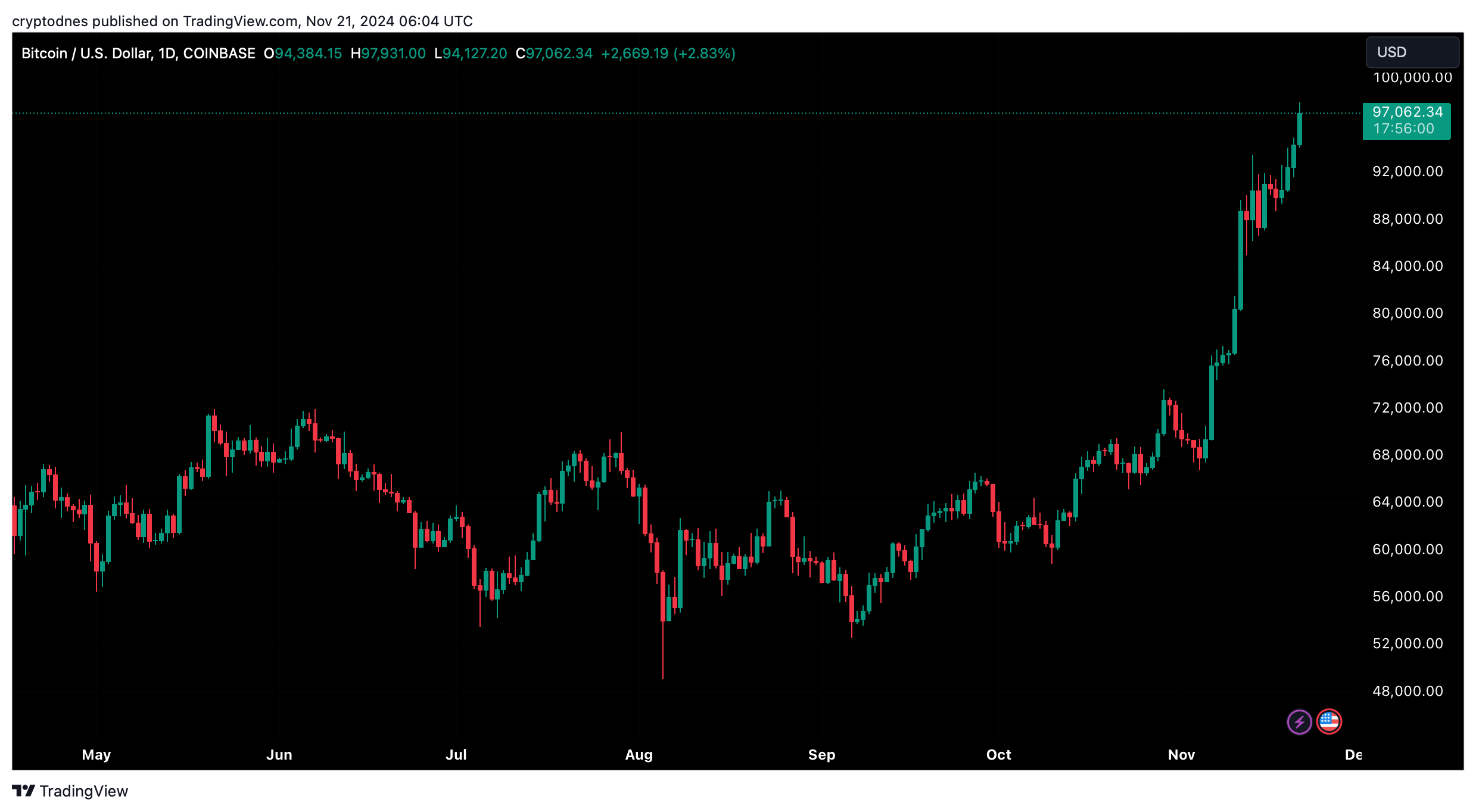Bitcoin Price Surges Above $97,000 – Here’s What Drove the Momentum
21.11.2024 8:13 1 min. read Kosta Gushterov
On November 21, the price of Bitcoin reached an all-time high of $97,600, fueled by renewed optimism following Donald Trump’s re-election as President of the United States.
The world’s largest cryptocurrency has seen a meteoric rise of over 120% since the start of this year, more than tripling from $30,000 in 2023 to its cent at the time of writing – $97,050. As Bitcoin inches closer to the $100,000 mark, its market capitalization has reached an impressive $1.93 trillion.

Analysts attribute this unprecedented growth to increasing institutional investments and the launch of Bitcoin ETFs, which have attracted billions in inflows.
Trump’s Pro-Crypto Agenda
Following Trump’s re-election two weeks ago, Bitcoin has surged by 40%, driven by his promise to make the United States the “crypto capital of the planet.” Reports indicate that Trump’s team is working on creating a dedicated White House role for cryptocurrency policy, signaling regulatory clarity and government support for digital assets.
Industry leaders, such as Edul Patel from Mudrex, highlight the administration’s pro-crypto stance as a key factor influencing market sentiment. The introduction of options trading for Bitcoin ETFs registered in the U.S. and MicroStrategy Inc.’s plans to increase BTC purchases further underscore this rally.
-
1
Bitcoin Reaches New All-Time High Above $116,000
11.07.2025 7:56 1 min. read -
2
What’s The Real Reason Behind Bitcoin’s Surge? Analyst Company Explains
12.07.2025 12:00 2 min. read -
3
Peter Schiff Warns of Dollar Collapse, Questions Bitcoin Scarcity Model
12.07.2025 20:00 1 min. read -
4
Canadian Bank Sees Bitcoin Hitting $155,000 by 2025
15.07.2025 10:00 1 min. read -
5
Strategy Claims It Can Weather a Bitcoin Crash to $20K Without Trouble
16.07.2025 14:08 1 min. read
Bitcoin Risk Cycle Flips Again as Market Enters Safer Zone
Bitcoin’s market signal has officially shifted back into a low-risk phase, according to a new chart shared by Bitcoin Vector in collaboration with Glassnode and Swissblock.
Robert Kiyosaki Warns of 1929-Style Crash, Urges Bitcoin Hedge
Financial author Robert Kiyosaki is once again sounding the alarm on America’s economic health.
Metaplanet Adds $92.5M in Bitcoin, Surpasses 17,000 BTC Holdings
Metaplanet Inc., a Tokyo-listed company, has just added 780 more Bitcoin to its treasury. The purchase, announced on July 28, cost around ¥13.666 billion or $92.5 million, with an average price of $118,622 per BTC.
China and U.S. Plan Trade Truce Extension Before Talks: How It Can Affect Bitcoin
The United States and China are expected to extend their trade truce by 90 days. The extension would delay new tariffs and create space for fresh negotiations in Stockholm.
-
1
Bitcoin Reaches New All-Time High Above $116,000
11.07.2025 7:56 1 min. read -
2
What’s The Real Reason Behind Bitcoin’s Surge? Analyst Company Explains
12.07.2025 12:00 2 min. read -
3
Peter Schiff Warns of Dollar Collapse, Questions Bitcoin Scarcity Model
12.07.2025 20:00 1 min. read -
4
Canadian Bank Sees Bitcoin Hitting $155,000 by 2025
15.07.2025 10:00 1 min. read -
5
Strategy Claims It Can Weather a Bitcoin Crash to $20K Without Trouble
16.07.2025 14:08 1 min. read


